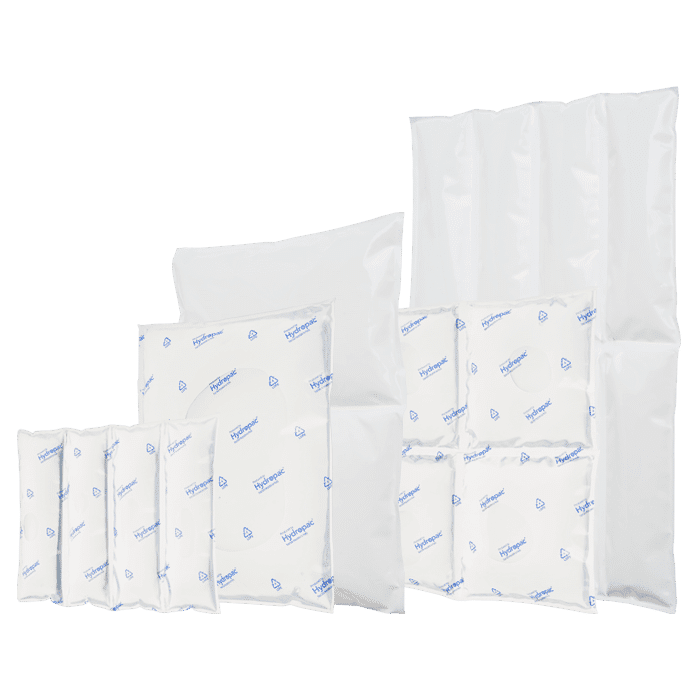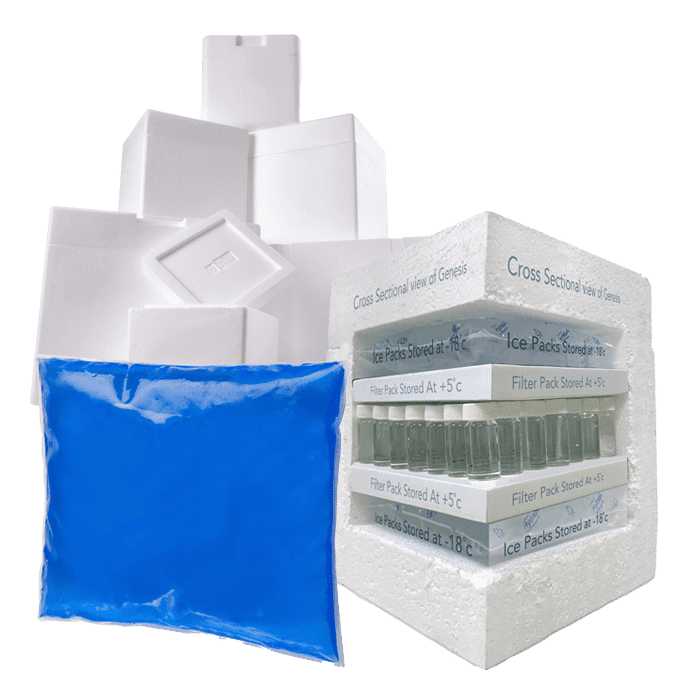HydroFreeze™ IcePacks v Dry Ice for Shipping
There has been a lot of talk recently regarding safer alternatives for dry ice; whilst it is extremely effective in keeping food and medical supplies at a stable temperature during shipping, it is important that anyone working with dry ice should be aware of the health risks when doing so. Dry ice can pose a number of hazards; as it melts, it turns into carbon dioxide gas – whilst this is not toxic, in a small or badly ventilated space, it lowers the pressure of “normal air”. In addition, anyone who handles dry ice without adequate PPE can risk getting a dry ice burn – this is because it is so cold, it kills the cells in your skin upon contact.
As we’ve developed our Ice Pack range, we have spent a lot of time working on a safe alternative for dry ice – obviously traditional water or gel ice packs can be used for shipping temperature sensitive products, but they don’t last as long as dry ice does, and therefore cannot compete in this market.
Custom chilled solutions for you
Hydropac offers every customer a customized solution for chilled and conditioned shipping. For example, we help a customer with limited freezing capacity to deliver gel packs frozen and ready to use, and we can manufacture almost all shapes and sizes of cooling elements. As a customer, you come first: we are here to help you.
Enter the HydroFreeze™ range of ice packs! These are a safe alternative to dry ice, offering up to 36 hours frozen shipping with no sublimination or hazard risks.
There are currently 3 different options in this range; these are:
HydroFreeze™
Our original dry ice alternative, HydroFreeze™ is a gel ice pack that contains a unique, food safe formula designed to phase change at -20 °C and maintain frozen temperatures below -12°C for approx. 24 hours
- The gel formula itself is made of only natural, food approved ingredients.
- As such, these ice packs do not need to be classed as Hazardous Goods during transit (which dry ice does, as it is classified by the DOT and IATA as a miscellaneous hazard (Class 9) during transportation).
- HydroFreeze™ ice packs do not require any specialist handling.
- HydroFreeze™ can maintain frozen temperatures up to -12°C for 24 hours.
HydroFreeze™+
- HydroFreeze™+ offers longer frozen shipping times; like the original HydroFreeze packs
- HydroFreeze™+ phase changes at -20°C and can then hold frozen foods at -20°C for approx. 24 hours or -15°C for approx. 36 hours.
- The gel formula is again non-toxic, made only of FDA approved agreements.
- These ice packs can offer these extended freeze times partly through increased energy absorption during the initial freezing process, which means they must be placed inside a powerful freezer to absorb fully in a
EasiFreeze™
EasiFreeze™ has been introduced as the latest in our specialty ice pack range for the shipment of frozen goods. EasiFreeze™ joins the HydroFreeze™ ice packs as a safe alternative to dry ice with a non-toxic gel formula that is FDA approved and drain safe. No specialist handling required!
- EasiFreeze™ has a freezing point of -16 °C (must be frozen at least at -30°C to freeze)
- EasiFreeze™ provides a long duration temperature hold below -12 °C.
How do HydroFreeze™ Ice Packs compare to Dry Ice?
Dry ice lasts around 24 hours in a standard cooler (although maintains a much lower temperature than this, far lower than any food or medicines require), but this time largely depends on the amount of dry ice being used. On average, you need around 10lb to last this long; in comparison, our smallest 660g HydroFreeze™ ice pack will last 20 hours, although you would need multiples to maintain the temperature for larger shipments.
Whilst dry ice does work well for shipping temperature sensitive products, the benefits must be weighed up against the negatives, particularly the health risks associated with using this method of maintaining temperature.
- Some carriers charge extra for shipping products containing Hazardous Goods
- Anyone handling dry ice must wear adequate PPE to prevent against frostbite or cold burns
- They must also make sure they are in a well ventilated space, to stop a build-up of carbon dioxide gas
- Whilst we don’t advocate simply binning our ice packs, if you do, they will not release any toxins into the environment – please note though that the emptied pouches are fully recyclable. In comparison, dry ice should never be disposed of in a normal bin or even in a chemical waste container; even when fully evaporated it needs to be sent to a specialist site that accepts hazardous waste goods.
- The UK has recently been subject to a number of CO2 shortages, which directly impact the production of dry ice and have a knock on effect on both availability and price. By switching to an alternative, these shortages and costs become a problem of the past.
Ultimately, if you need a safer alternative to dry ice that will also save on additional shipping costs, then look no further than the HydroFreeze™ range. Available in both freezer trays and courier boxes for differing requirements, these ice packs will give you all the plus points that dry ice can, without the health risks and extra costs!
Sustainability Hydropac and CSR
Sustainability isn’t just a trend for us – it’s a promise. As we innovate, create, and lead, we keep our planet’s well-being at the forefront. With Hydropac, you’re not just preserving the quality of your cargo; you’re contributing to a healthier world.
Experience the power of sustainable temperature assurance with Hydropac – where excellence and environmental responsibility coexist for a brighter future.





